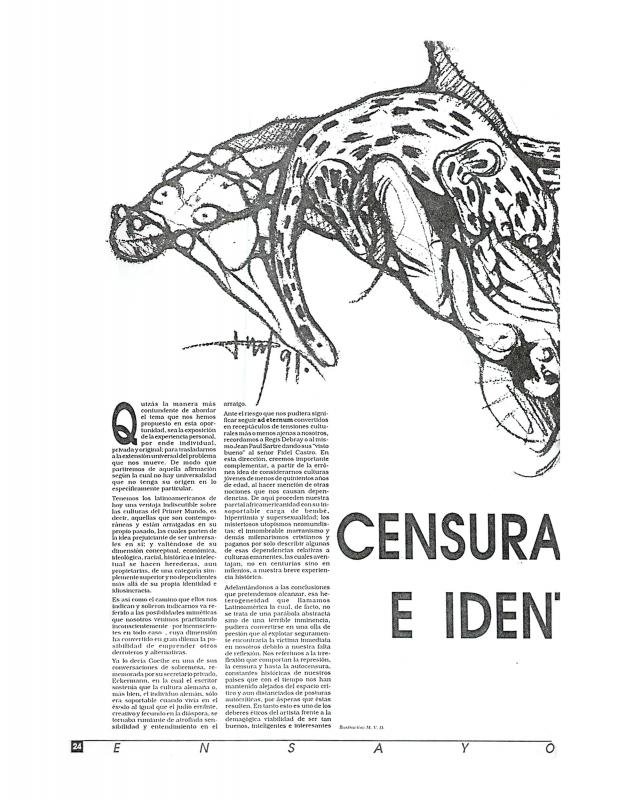This essay by the critic and historian Francisco Da Antonio (b. 1930)—which appeared in the catalogue for Cristos (Caracas: Galería El ave que llovía, 1972), the exhibition of works by the German-born Venezuelan visual artist Miguel von Dangel (b. 1946)—is an earnest defense of both the artist’s controversial piece Retrato espiritual de un tiempo and of the particular religious perspective expressed in his art. While this work was on display at the Palacio de las Academias in Caracas, by the way, it was destroyed by a priest, monseñor Augusto Laborem, who considered it a “desecration.” This act sparked a heated debate that played out in the national press. The work featured a crucified stuffed dog wearing a crown of thorns. Since the Retrato espiritual de un tiempo does not actually depict Christ, Da Antonio finds von Dangel’s work to be perfectly acceptable. The fact is that there have been countless paintings of Jesus on the cross, seen from many different perspectives, throughout the history of art, and animals have certainly been portrayed as part of the Christian liturgy. Though the critic defends the artistic sensibilities involved, the work’s message—a protest against the cruelty of a period in time and its passionate Christian faith— remains in question. That is, Da Antonio thinks that it has yet to be determined whether von Dangel’s work is art or not. [To read other articles and essays about this artist’s work, see in the ICAA digital archive by Yasmín Monsalve “Mi obra ha tenido que luchar contra muchos prejuicios: un premio nacional visto con la luz de Petare” (doc. no. 1102125); the essays by Elsa Flores “Miguel von Dangel: la respuesta latinoamericana (I)” (doc. no. 1155150), “Miguel von Dangel: la respuesta latinoamericana (II)” (doc. no. 1154906), and “Miguel von Dangel” (doc. no. 1056044); by Roberto Montero Castro “Transfiguraciones de Miguel von Dangel” (doc. no.1153996); the essays by María Luz Cárdenas “La Batalla de San Romano de von Dangel (I)” (doc. no. 1154028), and “La Batalla de San Romano de von Dangel (II)” (doc. no. 1154092); by Ruth Auerbach “Hoy, el paisaje es aquí y ahora” (doc. no. 855314); by Enrique Viloria “Miguel von Dangel: La conservación del paisaje americano” (doc. no. 1154827); and by Lourdes Blanco “Miguel von Dangel” (doc. no. 1097326); the interview by Axel Stein “Interview with Miguel von Dangel” (doc. no. 1102348); the one with María Cecilia Valera “Entrevista con Miguel von Dangel” (doc. no. 1154060); and the interview by María Josefa Pérez “Miguel von Dangel: No creo el cuento de que Reverón era loco” (doc. no. 1154012); and, finally, the articles by Víctor Guédez “Lo barroco y lo simbólico en la obra de Miguel von Dangel” (doc. no. 1154124), and by Juan Carlos Palenzuela “De engaños y otras lidias” (doc. no. 1154044). [See also other writings by Miguel von Dangel, such as “Acotaciones al tema de la crueldad en el arte. En memoria de Pedro Américo (Brasil 1843–1905), pintor de Tiradentes Descuartizado” (doc. no. 1102157), a story about the death of a horse that was used for experiments; “Demonología y arte” (doc. no. 1102173), a reflection on contemporary Venezuelan art; “San Romano” (doc. no. 1101572), a selection of notes from the artist’s diary; “Tres acepciones de iconografía virtual” (doc. no. 1102141); and “Censura e Identidad” (doc. no. 1154570), a review of different ideas about Latin American identity and Utopias].




















